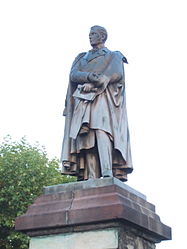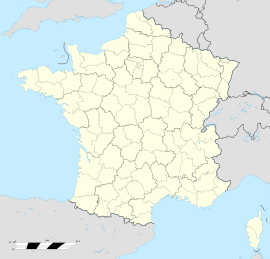- Decazeville
-
Decazeville

Statue of Élie Decazes 
Administration Country France Region Midi-Pyrénées Department Aveyron Arrondissement Villefranche-de-Rouergue Canton Decazeville Mayor Jean Reuilles
(2008–2014)Statistics Elevation 163–454 m (535–1,490 ft)
(avg. 225 m/738 ft)Land area1 13.88 km2 (5.36 sq mi) Population2 6,164 (2008) - Density 444 /km2 (1,150 /sq mi) INSEE/Postal code 12089/ 12300 1 French Land Register data, which excludes lakes, ponds, glaciers > 1 km² (0.386 sq mi or 247 acres) and river estuaries. 2 Population without double counting: residents of multiple communes (e.g., students and military personnel) only counted once. Coordinates: 44°33′35″N 2°15′23″E / 44.5597222222°N 2.25638888889°E
Decazeville (Occitan: La Sala) is a commune in the Aveyron department in the Midi-Pyrénées region in southern France.
The commune was created in the 19th century because of the Industrial Revolution and was named after the Duke of Decazes (1780–1860), the founder of the factory that created the town.
Contents
History
The town is built on coal. La Salle (the former name) produced coal since the 16th century. It was exported in small quantities to Bordeaux.
Louis XIV and his successors gave mines to their mistresses. The Duke of Decazes inherited such mines, and in 1826 he created, with the help of a technician named Cabrol, the "Houillères et Fonderies de l'Aveyron" (Mines and Foundries of Aveyron) which were to make this small village into a center of ironworking.
Under Napoléon III, the city took the name of Decazeville, and a statue of Decazes dressed in a Roman toga was erected.
The high point of iron production was reached early in the 20th century, with 9000 employees and 1 million tons of steel produced. The production then decreased, and the town has since diversified its industry: metallurgy, woodworking, metal fabrication, and production of steel tubing.
Although it felt the full brunt of the decline in the mining industry, the town has much thriving industry.
A noted strike of mine workers occurred from 1961 to 1962. Some 1500 miners spent 66 days in the mines from 23 December 1961 to 26 Febrruary 1962. The last mine closed in June 2001.
The town has a geological museum named after Pierre Vetter, its founder. It is dedicated to coal strata.
The open-pit mine La Découverte is open to the public.
The modern church of Notre-Dame has a celebrated painting of the Way of the Cross by Gustave Moreau.
Population
Historical population of Decazeville 1836 1841 1846 1851 1856 1861 1866 1872 1876 1881 2715 4154 6323 5938 8842 8620 7106 8710 9547 9625 1886 1891 1896 1901 1906 1911 1921 1926 10,702 8871 9634 11,536 12,961 14,144 14,089 14,261 1931 1936 1946 1954 1962 1968 1975 1982 15,210 12,365 12,138 11,510 11,855 10,532 10,231 8804 1990 1999 2008 7754 6805 6164 Personalities
- Élie Decazes (1780–1860), founder of the town and president of ministers under Louis XVIII.
- François Gracchus Cabrol (1793–1882), captain in the Napleonic army at 21, director of the mining enterprise. Buried in Decazeville.
- Emma Calvé (born 1858), singer born in Decazeville.
- Jean-Pierre Timbaud (1904–1941), World War II Resistance fighter worked briefly in the mines as a child.
- Paul Ramadier, mayor of Decazeville from 1919 to 1959, governor of Aveyron, and minister.
- Jacques Monfrin (1924–1998), philologist born in Decazeville.
- Serge Mesonès (1948–2001), footballer
- Jean-Claude Berejnoï (born in 1939), rugby player born in Decazeville.
- Lilian Bathelot (born 1959), novelist who spent his childhood in Decazeville.
- Henri Agel (1911–2008), cinema critic and philosopher who died in Decazeville.
- Maurice Frot (1928–2004), writer.
See also
- List of places named after people
- Héroïnes, a 1997 film partly set in Decazeville
- Virtual 3D tour in GE
- Communes of the Aveyron department
References
Categories:- Communes of Aveyron
- Aveyron geography stubs
Wikimedia Foundation. 2010.

